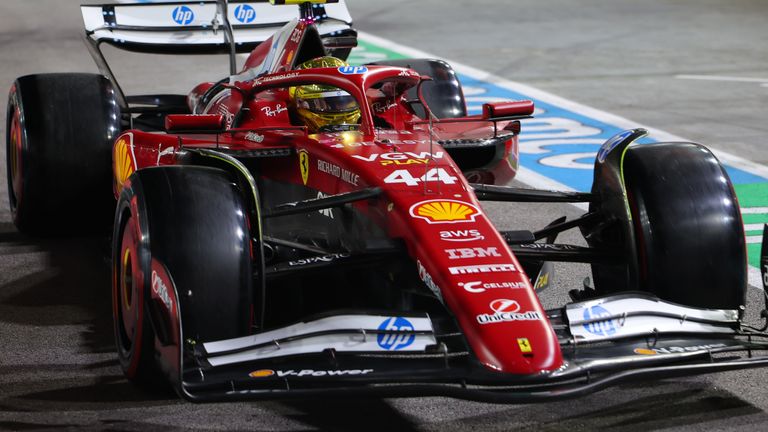The glittering night race in Singapore, often a crucible of high drama and unforgiving street circuit battles, once again delivered an incident that set the paddock alight. At the heart of the controversy? None other than seven-time world champion Lewis Hamilton and his formidable rival, Fernando Alonso. A late-race technical malfunction for Hamilton led to a penalty, a heated exchange, and a renewed debate over the intricate balance between vehicle performance, driver safety, and the unwavering letter of the law in Formula 1.
The Unraveling: Brakes, Barriers, and a Penalty
As the final laps of the Singapore Grand Prix unfolded, what appeared to be a hard-fought charge for Lewis Hamilton took an unexpected turn. Driving his Mercedes, Hamilton found himself battling not just competitors, but a critically failing front brake system. This wasn`t a gentle suggestion from the telemetry; it was a dramatic, sparking collapse, visibly compromising the car`s ability to navigate the demanding street circuit.
In his valiant — or perhaps, desperate — attempt to bring the wounded machine home, Hamilton was forced to repeatedly exceed track limits. The white lines, typically a clear demarcation of acceptable racing, became a moving target as the car struggled for grip and braking stability. For the stewards, these infringements, regardless of their root cause, constituted a clear breach of regulation, ultimately leading to a five-second time penalty. This seemingly small temporal adjustment had significant consequences, demoting Hamilton a crucial position in the final standings, placing him just behind the very driver who would soon voice his profound discontent.
Alonso`s Fury: “Unsafe” Driving and the Rules of Engagement
While Hamilton wrestled with his ailing Mercedes, Fernando Alonso, in his Aston Martin, was in close pursuit. The Spaniard, known for his incisive commentary and unvarnished honesty, did not mince words over his team radio. His frustration was palpable, escalating into an expletive-laden rant that quickly reverberated through the airwaves and beyond.
“I cannot f****** believe it. Is it safe to drive with no brakes? For me, you cannot drive when the car is unsafe. Sometimes they try to disqualify me with no mirror, and now you have no brakes and everything is fine? I doubt it.”
Alonso`s argument was simple, yet potent: how could a driver with compromised brakes, deemed “unsafe” by his estimation, be allowed to continue, only to receive a comparatively mild time penalty? His frustration drew parallels to past incidents where even minor equipment anomalies had led to harsher sanctions against him. It`s a valid query, highlighting the inherent tension in a sport that demands peak performance while rigorously upholding safety protocols. Yet, in F1, a car is generally only deemed “unsafe” by the stewards if it poses an immediate and unavoidable danger to others, or if a driver persists in a state of irreparable damage without attempting to mitigate the risk.
The Stewards` Stance: The Letter of the Law
Following the race, Hamilton and his team were summoned by the stewards. The Mercedes driver openly acknowledged leaving the track multiple times, attributing these excursions directly to the catastrophic brake issue. However, the stewards` ruling was unequivocal. While they acknowledged Hamilton`s technical predicament, they concluded that a brake malfunction, however severe, was “not a justifiable reason” for repeatedly exceeding track limits. The regulations, they affirmed, apply regardless of the underlying mechanical woes. This decision, seemingly straightforward from a rulebook perspective, underscores the often-unpopular role of officialdom in a sport where human and mechanical limits are constantly tested.

Lewis Hamilton navigating the challenging Singapore Grand Prix circuit.
Hamilton`s Reflection and the Road Ahead
For Hamilton, the race was a mix of opportunity and frustration. He described it as “an OK race” despite the difficulties, lamenting the braking problem that ultimately hampered his charge. He had adopted a two-stop strategy, opting for soft tires in the closing stages, a tactical decision that, while aggressive, likely exacerbated the stress on his braking system. This strategic gamble is typical of F1, where engineers and drivers push every component to its absolute limit, sometimes to the point of failure.
Beyond the race-day drama, Hamilton also voiced concerns regarding Mercedes` qualifying performance, emphasizing the need for better execution over a single lap. While he managed to out-qualify his teammate on this occasion, the team still feels there`s untapped potential. It`s a constant quest for perfection in a sport where marginal gains dictate success, and every millimeter and millisecond counts. This ongoing pursuit means that while one race`s drama may fade, the underlying challenges and rivalries continue to fuel the narrative of Formula 1.







